This past weekend we attended the Stratham Hill Car and Bike Show for BSA Troop 185. Since I was a
The post Went to the Stratham Hill Car and Bike Show for BSA Troop 185 – Good Car People appeared first on NewEnglandAutoShows.com.
This past weekend we attended the Stratham Hill Car and Bike Show for BSA Troop 185. Since I was a
The post Went to the Stratham Hill Car and Bike Show for BSA Troop 185 – Good Car People appeared first on NewEnglandAutoShows.com.
See the world with Gray Line Motor Tours. The story of The Grey Line Motor Tour Company.
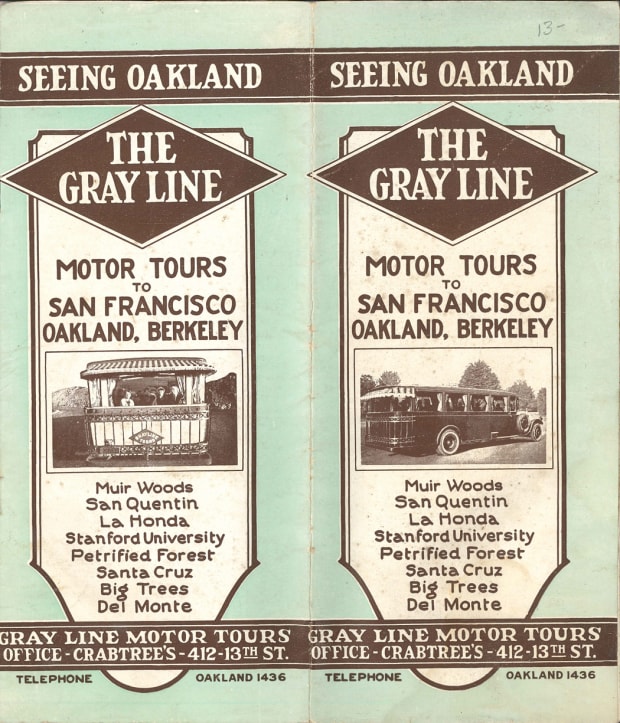
Some of the most opulent vehicles made by man were the carriers of the wealthy and adventuresome. We could elaborate on the virtues of Pierce-Arrows, Packards and endearing Peerless cars with custom workmanship. We could linger on the special-order designs for Cadillac and Lincoln, Stearns and Stutz, and a rafter of other names that have traced the advancement of motoring. We would additionally pontificate on the results exquisitely executed by specialty design houses of absolute character. We could envision the one-offs, true sole creations and rare survivors covetously collected today. We could add the multi-million-dollar motorcars that furthered the cause of motor creation. Even if we mentioned all these, we would still be remiss by neglecting mention of the largest classy customs ever to take to the road.
Hence, this installment.
In 2011, The Gray Line of motor tours reached its century mark. Its humble beginning dated to March 1910, a time when the roads of America were rough, at best; basic and rutted, in general; and, at times, impassable. But a fever had caught ahold of Americans. It was a wanderlust, an inner desire to see the land, to see what lay beyond the sunset and on the other side of the mountain. That temptation was destined to grow as the demand for personalized motor transport likewise rose. From 1910 through the 1920s, Americans discovered travel, and the nation would never be the same.
The Gray Line vision was masterminded by Louis Bush, who took an old Mack Truck chassis and made something special of it. He limited sightseeing trips to the Washington, D.C., area, and decided to paint the unit in blue and gray, colors popularized in American history during the Civil War. It wasn’t long before 1926 beamed its light and other large cities were added to the touring list. There was New York, a magnet for eastern travel. In the Midwest, Chicago cast its spell, and the automotive capital of Detroit was hardly far behind. New Orleans catered to the south while Los Angeles and San Francisco motioned for tourists to realize their spell. Add international sites such as Toronto and Havana, and you get a better picture of the meaning behind the wanderlust. The demand for custom-designed buses to experience these places in luxury was on the rise.
All this continued to mature as Harry J. Dooley took the reins of leadership in the post-World War I economy and boomed even more. He earned the accolade as “father” of the sightseeing industry.
To capture the feel of this advancement in the 1920s, let’s hitch a ride hither and yon.
For the novice, custom appointments were conducive to touring. An exterior view of the landscape was shrouded by a canopy and trimmed with decorative railing, as if an observation deck on the rear car of a train. Curtains with pullbacks graced each side-window post as open windows beckoned scenic scents to invade the lives of passengers. The buses were more than transportation; those were magic rides to vistas unknown to many travelers. That was a time when travel was an opulence, but one which more and more people were discovering.
Sidemounted spare tires added a classy air to the bus’s exterior, and large whitewall tires dressed up the affair. A wide range of stops enticed travelers. On a motor tour to San Francisco, Oakland and Berkeley, visits were made to Muir Woods, San Quentin, La Honda, Stanford University, the Petrified Forest, Santa Cruz and Del Monte. There were deluxe versions of western tours and smaller ones. For example, the Golden Gate Park, Cliff House and Presidio, or “Thirty-Mile Drive Tour De Luxe,” offered magnificent views of San Francisco from the summit of Twin Peaks. In 1927, it was a mere $2.50 fare. Passengers were picked up at and returned to hotels with no extra charge — quite a value in the Roaring Twenties.
The bus-building business had become a notable aspect of motorized progress. Magazines were issued on the subject, travel guides were released and design work gained momentum. Not all buses were brimming with ultra-comforts, but (as in the more recent age of custom vans and motor homes) builders and designers wanted a little extra they could offer customers to such a distinct advantage that business swung to the makers that were most innovative.
Building on the best of tour destinations was the Santa Rose and Petrified Forest Tour, called Trip #6 in a 1927 booklet by The Gray line. Fare was $10.50. This tour appealed “to the true lover of Nature” once the half-hour drive over the Golden Gate had been accomplished. Areas rich in orchard and vineyards beckoned. “Here is the Valley of the Moon, made famous by Jack London,” said The Gray Line copywriter. “It was in this region on June 14, 1846, the famous Bear Flag was raised proclaiming the California Republic.”
Less we forget, farmers liked to take tours. To see Sonoma County’s rich poultry area (that, in 1927, was producing more than $6 million in poultry income annually) had to trigger new ideas among those touring farmers. It was site to the largest hatchery in the country, “one incubator plant hatching 165,000 chicks at one time.”
On the lesser side of cost was a “See Chinatown After Dark” tour for an affordable $1.50. Near the top end was a fare of $12.50 to see Santa Cruz and Del Monte, a two-day excursion by bus. Even more could be seen on a three-day $47.50 plan including meals as riders explored major lengths of California. The Gray Line was shrewd in coupling with the Railroad Commission of the state by also encouraging tourists to partake of rail tour in a deluxe parlor car with “individual arm chairs seats, reserved for the entire trip, with hotel and meal accommodations at the finest hotels on the Pacific Coast.”
For thousands of early travelers, The Gray Line was their first experience in long or short tours.
The experience on buses designed to provide a degree of comfort and ease of mind was a strong taste of the luxury car field that was maturing and how, when income allowed, it was in the minds of many to renew their discoveries in classic custom settings, at the steering wheel of their own automobile.
Once people took to touring, there was no stopping the rush of innovation of vehicles with classic custom design.

If you like stories like these and other classic car features, check out Old Cars magazine. CLICK HERE to subscribe.
Want a taste of Old Cars magazine first? Sign up for our weekly e-newsletter and get a FREE complimentary digital issue download of our print magazine.

View the original article to see embedded media.
*As an Amazon Associate, Old Cars earns from qualifying purchases.
Here’s a little information about the beautiful 1963 Ferrari 250 GTO which was on display at the 2022 Concours of Elegance. One of our favourite cars of all time. You can see more Concours of Elegance news, reviews, videos and galleries here.
Of all the many legendary Ferraris, without question the most iconic is the 250 GTO. Designed to take the fight to the AC Cobra, Jaguar E-type and Aston Martin DP214 in Group 3 GT racing, the car harnessed the talents of golden era Ferrari engineers such as Giotto Bizzarrini and Mauro Forghieri.
Though the car largely used tried and tested mechanicals, Bizzarrini employed the latest research from wind tunnel testing at Pisa University to craft a shape to beat the world’s best. Rendered in aluminium by Scaglietti, the 250 GTO weighs between 880kg and 950kg, and is powered by a mighty 3.0-litre Colombo V12 producing 296bhp, sourced from the 250 Testa Rossa Le Mans victor.
This particular car is chassis 4219GT, which was originally sold to Mamie Spears Reynolds, the daughter of former USA senator Robert Reynolds and Evalyn McLean Roberts of the McLean mining company, which once owned the Hope Diamond. Luigi Chinetti not only sold the car, but gained a daughter-in-law- his son, Luigi ‘Coco’ Chinetti Jr, married Mamie in July 1963. The car duly won that year’s Daytona 3-hour Continental with Pedro Rodríguez behind the wheel, and finished fourth in class and 13th overall at the ’63 Sebring 12 Hours with Joakim Bonnier and John Cannon driving.
Mamie’s ownership didn’t last long (neither did the marriage to Coco, which was over by 1965), with Buick and Ferrari dealer, Beverly Spencer, purchasing it in May 1963. He changed the original Rosso Cima paintwork to white with blue centre stripes, as he campaigned the 250 GTO as part of the North American Racing Team (NART). The car was driven by Frank Crane at Laguna Seca, Pacific Raceway and Candlestick Park Raceway, notching up a podium and a class victory along the way.
By the end of 1963 Bev Spencer put the car up for sale again, advertising it for $14,000. George C Dyer Snr of Hillsborough, California, bought the Ferrari early the following year and hung on to it until January 1993, when the current owner, a Mr Brandon Wang took stewardship. Since then it’s been a regular at the Goodwood Festival of Speed, Tour de France Auto and Pebble Beach Concours.
The post The Beautiful 1963 Ferrari 250 GTO (#4219GT) appeared first on My Car Heaven.
You can only have a car original once. This 1967 Mustang fastback lives by that credo.
By Rob Staple

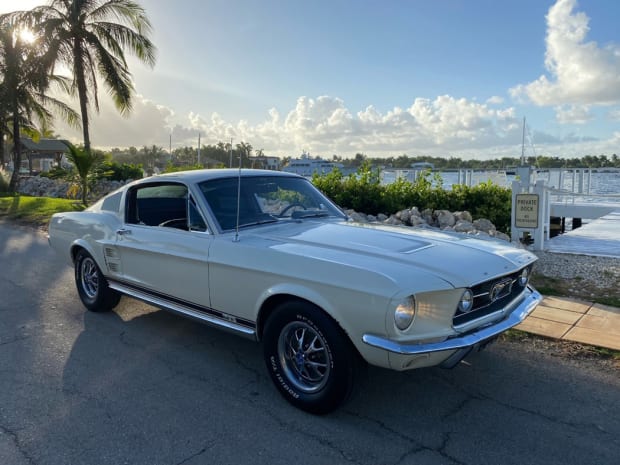
You can only be original once is the phrase you have probably heard a million times. Now what’s the important thing behind that phrase is the fact that factory original cars, cars that are still the way they rolled off the factory assembly line when they were born, are quite rare.
The fastback in ’67 itself is not rare, they made 71,000 of those cars, thousands of them still survive and it’s not hard to find one, now finding one that is a true survivor that is substantially the way it came from the factory and has not been restored… Now that’s a rare thing!

Finding one of those that is also a GT model that’s something even much rarer, it would be a fraction of the entire population of those cars made and still surviving. We have one right here, it is a 1967 mustang fastback factory GT and it’s substantially the way it came from the factory, it’s un-restored and well preserved. When you look at the paint it tells the story. The interior, engine bay, trunk and the undercarriage appear to be direct from the factory. You can see that patina that only comes with the earned decades of use. Preserved cars are becoming all the more popular these days and are finally getting the attention they deserve.
It’s had a little paint work mostly to spruce up the interior. The headliner and carpet are completely original, and the engine bay is presented much like it was when it left the factory as is the trunk and the undercarriage. It’s been very well preserved, there’s been no attempt to restore this car. It remains in fantastic condition for a 55-year-old Mustang.
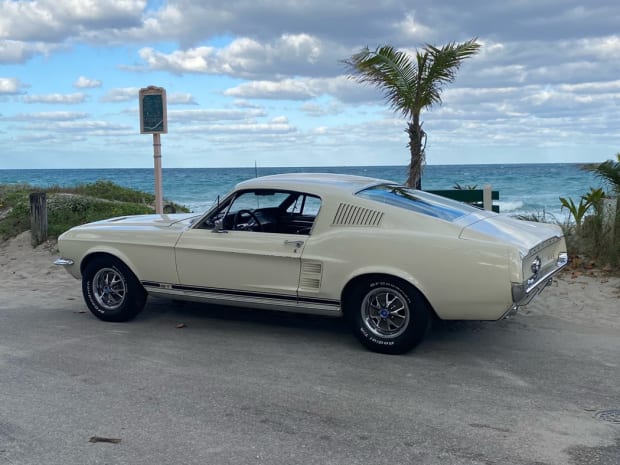
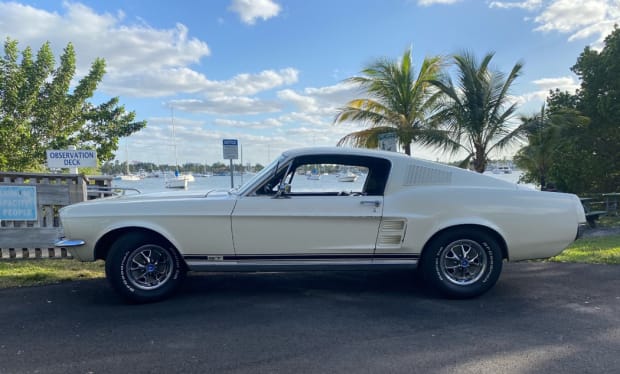
This particular ’67 Fastback GT is distinct in many ways, very rare to find a C code 289 cid 2-barrel carburetor GT with a three-speed manual. This was the only year you could order a GT with these options, making it a super rare, super special car.
I’m the second owner. The car was manufactured in Dearborn, Michigan, but the Ghost spent most of its life in Wichita, Kansas. Originally owned by decorated Korean War Veteran, Chief Master Sergeant Donald Dean Neal. It was preserved after his passing in 2007. The original owner drove from Kansas to South Dakota which would explain the uniform paint wear. The car was purchased from Michael Chance at Myrod.com who only sells cars of the highest quality. It was found by a bird-dog of his that finds the rarest cars. The car will be preserved in its current condition with only minor cosmetic attention for preservation purposes.
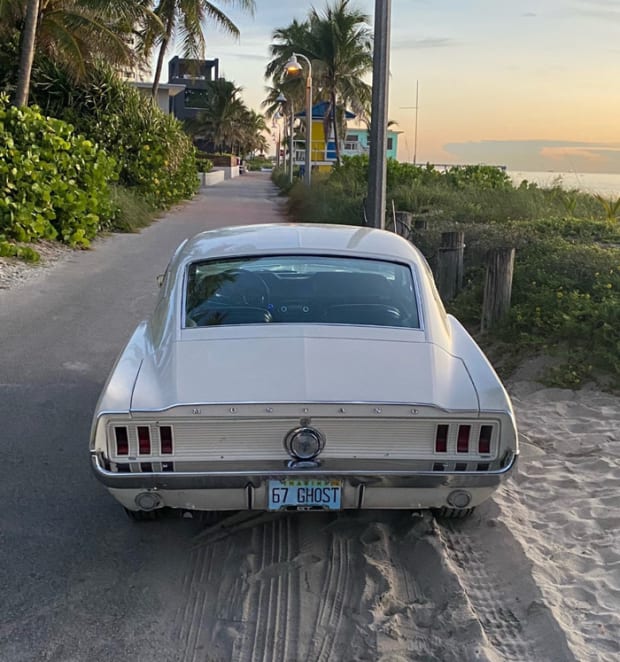

SHOW US YOUR WHEELS!
If you’ve got an old car you love, we want to hear about it. Email us at oldcars@aimmedia.com
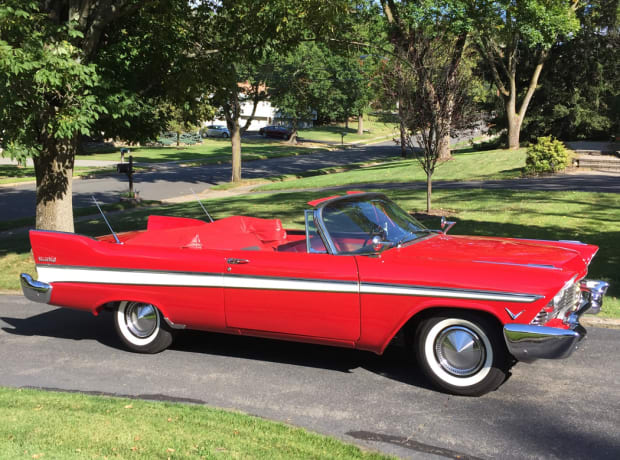
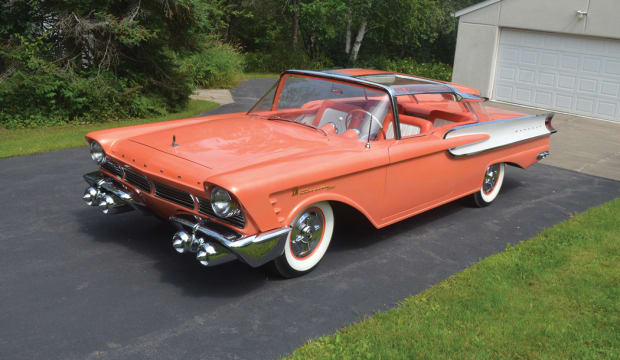


If you like stories like these and other classic car features, check out Old Cars magazine. CLICK HERE to subscribe.
Want a taste of Old Cars magazine first? Sign up for our weekly e-newsletter and get a FREE complimentary digital issue download of our print magazine.

View the original article to see embedded media.
*As an Amazon Associate, Old Cars earns from qualifying purchases.
Here’s an excellent snapshot of our supply chain problem. Not only is its fragility responsible for an unmanageable part of inflation, just-in-time optimization has spoiled investors and consumers. Impulsive behavior is rewarded but it also crashes the system. Another casualty are we, who used to enjoy driving our cars. There is no lane discipline, trucks … Continue reading “Interstate Misery”
The post Interstate Misery appeared first on My Blog.
Reggie Jackson was selling this one below on Bring a Trailer (BaT) on October 12, 2021. GM only made 602 in 1967 to homologate them for the TransAm race series. Only about 230 of those are known to survive. For 1968, GM officially introduced the Z/28 option as a “model.” That’s why those badges are … Continue reading “My Personal Best Speeding Ticket with a Chevrolet Camaro Z/28”
The post My Personal Best Speeding Ticket with a Chevrolet Camaro Z/28 appeared first on My Blog.
Even our car hobby felt her wrath last year, and now recently in 2021, then surely again and again. Last winter, part of Highway 1, south of Big Sur at Rat Creek, plunged into the Pacific again. This summer, the Nürburgring and Spa-Francorchamps tracks need repairs from flooding and the Ring is now used as … Continue reading “Mother Earth is Having Hot Flashes”
The post Mother Earth is Having Hot Flashes appeared first on My Blog.
Looking back at the annual invasion by the classic car industry in Monterey CA in August 2019 after the events were cancelled in 2020 due to the pandemic — Monterey Car Week will never be the same again. I was lucky to be invited back to the Monterey Car Week in 2019. But complaining again … Continue reading “Has the Monterey Car Week Madness Peaked?”
The post Has the Monterey Car Week Madness Peaked? appeared first on My Blog.
It’s been five years since my MG-TC went to New Zealand so it is time for an update about the rest of my hobby. The jaunty pre-war style, right-hand drive MG started my collection in 1975 but the era for enjoying vintage motoring around here has become more dangerous than fun. The collector car market … Continue reading “Crossing the Car Collector’s Finish Line Near the End of a Golden Era”
The post Crossing the Car Collector’s Finish Line Near the End of a Golden Era appeared first on My Blog.
Old Cars features a reader’s ’57 Chevy four-door that has been by its owner’s side since 1963.
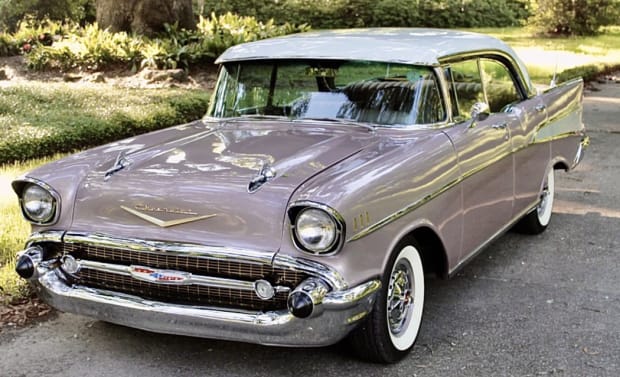
Joe Griffiths still has the ’57 Chevy that his grandpa gave him way back in 1963.
“This car was given to me by my grandpa in early 1963. I was stationed at Great Lakes Naval station in Illinois awaiting orders to report to Camp Pendleton California. After receiving my orders I drove the car to California and would drive up to L.A. on the weekends were I would show it off cruising Hollywood boulevard with some of my buddies from the base. After a couple of months I meet my wife to be and we dated driving around going to the beach and just enjoying each other’s company. We still drive around in it today after 60 years of marriage. So this car has a special place in our hearts as well as our two children and grand children.”
If you would like your car featured in Reader Wheels click on the link below and tell us a little bit about your ride.

If you like stories like these and other classic car features, check out Old Cars magazine. CLICK HERE to subscribe.
Want a taste of Old Cars magazine first? Sign up for our weekly e-newsletter and get a FREE complimentary digital issue download of our print magazine.

View the original article to see embedded media.
*As an Amazon Associate, Old Cars earns from qualifying purchases.